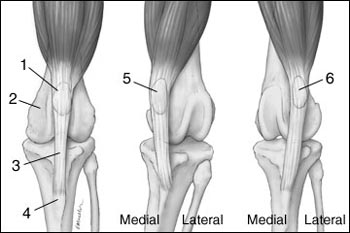Canine
Dislocating kneecap, luxating patella, loose knee, trick knee
Dogs, cats, humans
Patellar luxation is usually a congenital condition in which the kneecap, or patella, dislocates outside of its normal trochlear groove. Dislocation, clinically referred to as luxation, can occur on either the medial, or inside surface, or the lateral, or outside surface, of the knee. There are varying degrees of patellar luxation that are graded depending on whether the patella is intermittently or constantly luxated. This abnormal displacement of the kneecap results in pain, cartilage damage, and arthritis. There are varying degrees of severity of this disease, and surgery may be needed.
It is much more common for the kneecap to ride on the inside than on the outside surface of the knee. This condition typically affects small and miniature breeds such as the poodle, Pomeranian, Chihuahua, Schipperke, Bichon Frise, and pug. It is also seen in the cocker spaniel, golden retriever, Labrador retriever, and mixed breeds.

- Patella
- Femur
- Patellar ligament
- Tibial Tuberosity
- Medial Luxation of Patella
- Lateral Luxation of Patella
Outside dislocation of the kneecap, or lateral patellar luxation, occurs more often in large breeds such as the Great Dane, Saint Bernard, and Bernese mountain dog. Lateral luxation is often accompanied by malformation of the femur, the large bone in the thigh. In these cases the prognosis is more uncertain, as major limb reconstructive surgery may be needed.
Generally, the prognosis is better when corrective surgery is performed early in the course of the disease; many of the malformations in the bones and joint occur over time and can be prevented with early correction.
|
|














